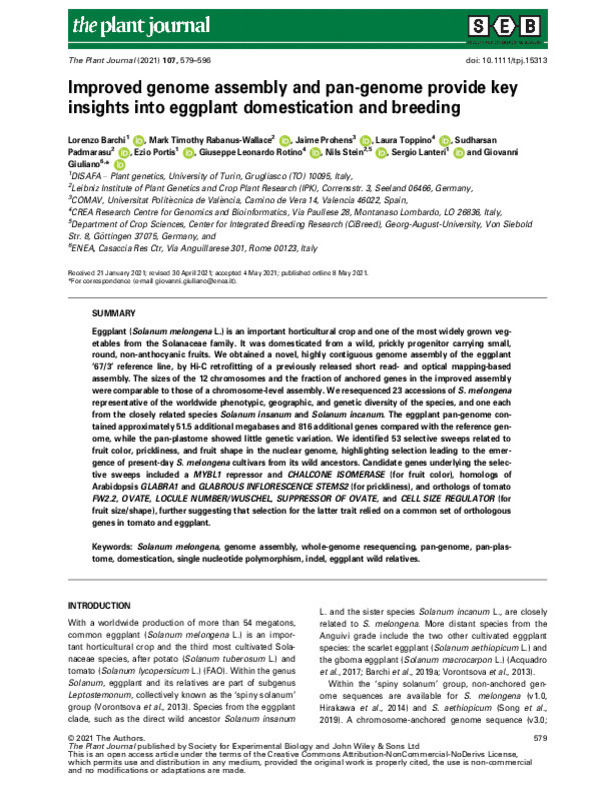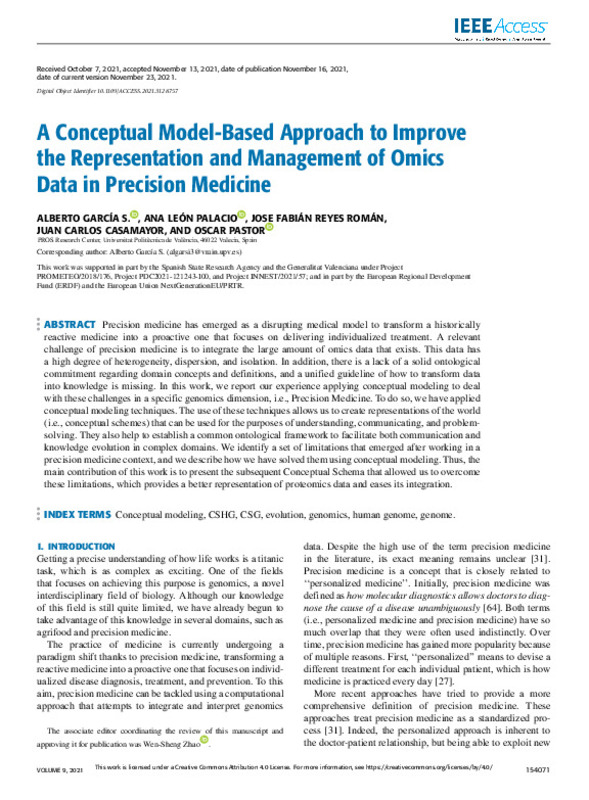JavaScript is disabled for your browser. Some features of this site may not work without it.
Buscar en RiuNet
Listar
Mi cuenta
Estadísticas
Ayuda RiuNet
Admin. UPV
Improved genome assembly and pan-genome provide key insights on eggplant domestication and breeding
Mostrar el registro sencillo del ítem
Ficheros en el ítem
| dc.contributor.author | Barchi, Lorenzo
|
es_ES |
| dc.contributor.author | Rabanus-Wallace, Mark Timothy
|
es_ES |
| dc.contributor.author | Prohens Tomás, Jaime
|
es_ES |
| dc.contributor.author | Toppino, Laura
|
es_ES |
| dc.contributor.author | Padmarasu, Sudharsan
|
es_ES |
| dc.contributor.author | Portis, Ezio
|
es_ES |
| dc.contributor.author | Rotino, Giuseppe Leonardo
|
es_ES |
| dc.contributor.author | Stein, Nils
|
es_ES |
| dc.contributor.author | Lanteri, Sergio
|
es_ES |
| dc.contributor.author | Giuliano, Giovanni
|
es_ES |
| dc.date.accessioned | 2023-04-27T18:01:14Z | |
| dc.date.available | 2023-04-27T18:01:14Z | |
| dc.date.issued | 2021-07 | es_ES |
| dc.identifier.issn | 0960-7412 | es_ES |
| dc.identifier.uri | http://hdl.handle.net/10251/192999 | |
| dc.description.abstract | [EN] Eggplant (Solanum melongena L.) is an important horticultural crop and one of the most widely grown vegetables from the Solanaceae family. It was domesticated from a wild, prickly progenitor carrying small, round, non-anthocyanic fruits. We obtained a novel, highly contiguous genome assembly of the eggplant '67/3' reference line, by Hi-C retrofitting of a previously released short read- and optical mapping-based assembly. The sizes of the 12 chromosomes and the fraction of anchored genes in the improved assembly were comparable to those of a chromosome-level assembly. We resequenced 23 accessions of S. melongena representative of the worldwide phenotypic, geographic, and genetic diversity of the species, and one each from the closely related species Solanum insanum and Solanum incanum. The eggplant pan-genome contained approximately 51.5 additional megabases and 816 additional genes compared with the reference genome, while the pan-plastome showed little genetic variation. We identified 53 selective sweeps related to fruit color, prickliness, and fruit shape in the nuclear genome, highlighting selection leading to the emergence of present-day S. melongena cultivars from its wild ancestors. Candidate genes underlying the selective sweeps included a MYBL1 repressor and CHALCONE ISOMERASE (for fruit color), homologs of Arabidopsis GLABRA1 and GLABROUS INFLORESCENCE STEMS2 (for prickliness), and orthologs of tomato FW2.2, OVATE, LOCULE NUMBER/WUSCHEL, SUPPRESSOR OF OVATE, and CELL SIZE REGULATOR (for fruit size/shape), further suggesting that selection for the latter trait relied on a common set of orthologous genes in tomato and eggplant. | es_ES |
| dc.description.sponsorship | This work was supported by the European Commission, Horizon 2020 G2P-SOL project (grant agreement no. 677379). We gratefully acknowledge Ines Walde and Axel Himmelbach for technical assistance. | es_ES |
| dc.language | Inglés | es_ES |
| dc.publisher | Blackwell Publishing | es_ES |
| dc.relation.ispartof | The Plant Journal | es_ES |
| dc.rights | Reconocimiento - No comercial - Sin obra derivada (by-nc-nd) | es_ES |
| dc.subject | Solanum melongena | es_ES |
| dc.subject | Genome assembly | es_ES |
| dc.subject | Whole-genome resequencing | es_ES |
| dc.subject | Pan-genome | es_ES |
| dc.subject | Pan-plastome | es_ES |
| dc.subject | Domestication | es_ES |
| dc.subject | Single nucleotide polymorphism | es_ES |
| dc.subject | Indel | es_ES |
| dc.subject | Eggplant wild relatives | es_ES |
| dc.subject.classification | GENETICA | es_ES |
| dc.title | Improved genome assembly and pan-genome provide key insights on eggplant domestication and breeding | es_ES |
| dc.type | Artículo | es_ES |
| dc.identifier.doi | 10.1111/tpj.15313 | es_ES |
| dc.relation.projectID | info:eu-repo/grantAgreement/EC/H2020/677379/EU | es_ES |
| dc.rights.accessRights | Abierto | es_ES |
| dc.contributor.affiliation | Universitat Politècnica de València. Escuela Técnica Superior de Ingeniería Agronómica y del Medio Natural - Escola Tècnica Superior d'Enginyeria Agronòmica i del Medi Natural | es_ES |
| dc.description.bibliographicCitation | Barchi, L.; Rabanus-Wallace, MT.; Prohens Tomás, J.; Toppino, L.; Padmarasu, S.; Portis, E.; Rotino, GL.... (2021). Improved genome assembly and pan-genome provide key insights on eggplant domestication and breeding. The Plant Journal. 107(2):579-596. https://doi.org/10.1111/tpj.15313 | es_ES |
| dc.description.accrualMethod | S | es_ES |
| dc.relation.publisherversion | https://doi.org/10.1111/tpj.15313 | es_ES |
| dc.description.upvformatpinicio | 579 | es_ES |
| dc.description.upvformatpfin | 596 | es_ES |
| dc.type.version | info:eu-repo/semantics/publishedVersion | es_ES |
| dc.description.volume | 107 | es_ES |
| dc.description.issue | 2 | es_ES |
| dc.identifier.pmid | 33964091 | es_ES |
| dc.identifier.pmcid | PMC8453987 | es_ES |
| dc.relation.pasarela | S\461410 | es_ES |
| dc.contributor.funder | European Commission | es_ES |
| dc.subject.ods | 02.- Poner fin al hambre, conseguir la seguridad alimentaria y una mejor nutrición, y promover la agricultura sostenible | es_ES |










